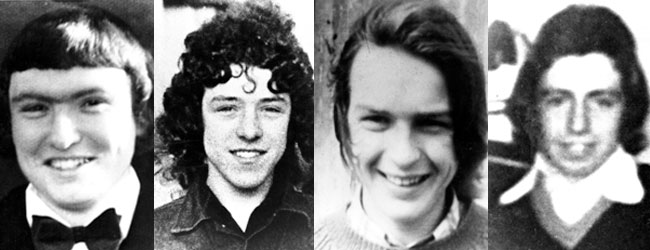9 September 2011
1981 HUNGER STRIKE | 30th ANNIVERSARY
SEPTEMBER
The last weeks of the Hunger Strike
WHILE Michael Devine would be the last Hunger Striker to die, on 20th August 1981, the Hunger Strike itself would continue on.
On 31st August, Gerard Carville (25), an IRA Volunteer from Greencastle in County Down, became the twentieth person to join the Hunger Strike. An enthusiastic GAA footballer and fisherman, Gerard was active in the Civil Rights Movement. His revulsion at the slaughter of civilians by British forces on Bloody Sunday led him to eventually join the Republican Movement in 1974, having been close to it for the previous two years. In 1977, Gerry was arrested and charged with possession of a rifle and participation in three IRA bomb attacks. He was sentenced to 14 years’ imprisonment and immediately went ‘on the blanket’.
In the first week of September, both Laurence McKeown and Matt Devlin were reported to be in a critical condition. Matt was taken off hunger strike on 4th September after his family intervened. Matt had gone 52 days without food. Laurence was eventually taken off hunger strike on 7th September, again after his family intervened. He was on the 70th day of his hunger strike. That same week, Sinn Féin’s Falls Road office was raided by the RUC with the personal files and medical details of the Hunger Strikers being removed from the H-Block Information Centre, which was housed in the same building.
On 7th September, IRA Volunteer John Pickering (25), from Andersonstown in west Belfast joined the Hunger Strike. John, a friend of Kieran Doherty TD, came from a family of 12 children: eight boys and four girls. A joiner by trade, John joined the Republican Movement in 1972, at the age of 16. He was interned without trial, aged 17, for three years before being released in November 1975. In August 1976, John, along with Kieran Doherty and two other Volunteers, was captured on the Malone Road and charged with killing a British soldier. John was sentenced to 26 years in prison.
Internationally, the Hunger Strike continued to focus attention on Ireland with a 7,000-strong protest taking place in Washington DC while more than 10,000 people protested outside the British Embassy in Paris.
On 14th September, Gerard Hodgins (21) became the twenty-second prisoner to join the hunger strike. A former cellmate of Bobby Sands, Gerard’s family were from the Springfield Road area of Belfast but were forced to move to Downpatrick after loyalist intimidation. An avid reader of Irish history, Gerard joined Na Fianna Éireann before later becoming an IRA Volunteer. Gerard was arrested in May 1976 and charged with possession of a pistol. He was sentenced to fourteen years imprisonment and immediately joined his comrades on the Blanket Protest.
As the weeks dragged on, many within Britain began to realise that the Hunger Strike was seriously damaging their standing worldwide. A BBC TV ‘Panorama’ documentary was screened which attacked British Prime Minister Margaret Thatcher, claiming that her inflexibility on the Hunger Strike was resulting in the channeling of funds, recruits and political capital to the IRA.
On 21st September, Glasgow-born IRA Volunteer Jim Devine (24) joined the Hunger Strike. When Jim was only a young boy his family moved back from Scotland to the unionist town of Comber in County Down. They were forced to leave the area in March 1973 after loyalist intimidation and threats, including one incident where Jim had a knife held to his throat. The family moved to Strabane and Jim became an apprentice electrician. In 1978, he joined the IRA but was soon arrested and charged with taking part in various gun and bomb attacks. In January 1979, he was sentenced to ten years’ imprisonment. Jim refused to wear a convict’s uniform and immediately went ‘on the blanket’.
Outside the prisons, the injuries and deaths caused by plastic bullets was a major issue, with Sinn Féin leading a several-thousand-strong demonstration through Belfast in opposition to their use. Only days after this protest, on 25th September, 18-year-old Michael Mervin was seriously wounded after a British soldier shot him with a plastic bullet at close range on Grosvenor Road. The young man had been walking home from a chip shop when a British patrol called him over to them. As he approached, he was shot in the face. Doctors at the Royal Victoria Hospital said he was lucky not to have lost his eyes.
The end of September also saw an increase in the number of loyalist attacks. In one incident. a UDA death squad opened fire on H-Block protesters in Ardoyne but, luckily, nobody was hit. That same weekend, the UDA murdered a 25-year-old Catholic civilian on Belfast’s Ormeau Roa and in Dungannon, H-Block activist Frank Gormley had two shots fired at him in an attempted UDA ambush.
As the month drew to a close, two more Hunger Strikers, Bernard Fox and Liam McCloskey, were taken off the Hunger Strike after their families intervened. They had been on the Hunger Strike for 33 and 55 days respectively.
The Hunger Strike would come to an end on 3rd October.
Follow us on Facebook
An Phoblacht on Twitter
Uncomfortable Conversations

An initiative for dialogue
for reconciliation
— — — — — — —
Contributions from key figures in the churches, academia and wider civic society as well as senior republican figures





